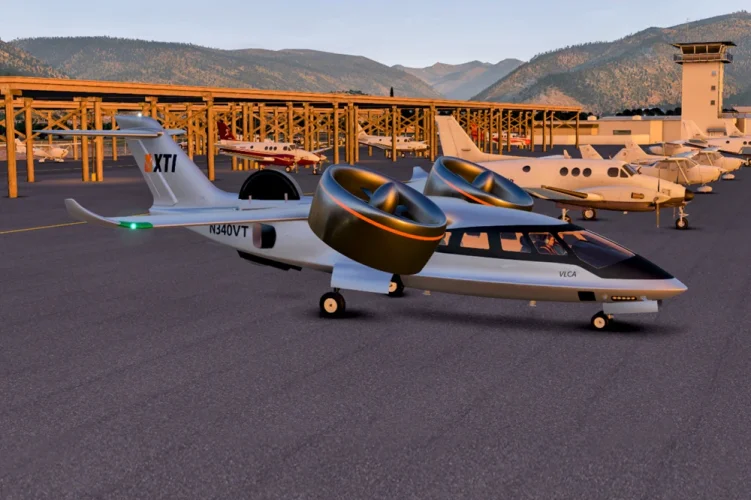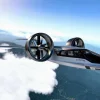- Directory
- Evtol | Electric Aircraft
- Jet Fuel/Electric eVTOL
- XTI TriFan 600

XTI TriFan 600
NewOperational Information
- Piloted
- Lift+Cruise
Performance and Capacity
- 3 Ducted Fans
- Honeywell HTS900
- Jet Fuel
Aircraft Design and Dimensions
The XTI TriFan 600 is a hybrid vertical lift crossover airplane (VLCA) under development by XTI Aircraft Company in Englewood, Colorado. Combining business-jet performance with helicopter-like VTOL capability, it targets regional point-to-point missions up to 700 mi (1,126 km) in VTOL mode and 850 mi (1,370 km) in CTOL mode at cruise speeds of 345 mph (555 km/h). Powered initially by twin Honeywell HTS900 turboshaft engines driving three ducted fans, the aircraft employs tilting front fans for transition to wing-borne flight while the rear fan is used exclusively for vertical operations. The all-composite airframe includes a pressurized cabin for one pilot plus six passengers, advanced fly-by-wire controls, retractable landing gear, and modern avionics from Garmin. By leveraging proven turbine propulsion and an optimized ducted-fan drivetrain, the TriFan 600 de-risks certification and offers extended range, speed, and payload capability far beyond typical short-range eVTOLs. Sustainability is addressed through compatibility with 100% SAF and planned future hybrid-electric or hydrogen-fuel-cell integration.
## Description
XTI’s vision with the TriFan 600 is to bridge the gap between helicopters and business jets, delivering rapid, direct connectivity without the limitations of runways. The aircraft’s design centers on three 72 in ducted fans housed in aerodynamic nacelles: two forward fans mounted on rotating pylons for VTOL-to-cruise transition, and one fixed rear fan for vertical operations. Twin Honeywell HTS900 turboshaft engines drive the fans via a complex gearbox and clutch system supplied by Triumph Geared Solutions, Kamatics, and Formsprag. This architecture enables three distinct flight modes: full-lift vertical takeoff/landing, transitional flight with front fans rotated forward, and CTOL operations using intermediate fan angles for short-field departures.
The carbon-fiber composite fuselage and wings feature a high main wing with winglets and a cruciform tail. Retractable tricycle landing gear supports versatile ground operations. The pressurized cabin seats up to six passengers around a central aisle, with large windows and configurable luxury interiors. A sliding fuselage door conceals the third fan during cruise, reducing drag. The fly-by-wire flight control system integrates advanced safety features, including envelope protection, autopilot, and synthetic vision.
Avionics selection—Garmin G700 TXi—provides dual touchscreen displays, synthetic vision, and integrated FADEC management, critical for seamless VTOL-to-cruise transitions. Noise mitigation is achieved through ducted fans, reducing acoustic footprint compared to open-rotor helicopters. Sustainability is emphasized via 100% SAF compatibility for up to 80% CO₂ reduction, with future retrofits planned for hybrid-electric and all-electric propulsion as infrastructure matures.
Intended missions include business air taxi, air ambulance, regional commuter, and VIP transport. With projected cruise altitude of 25,000 ft, the TriFan 600 aims to compete with light jets by offering helipad-to-helipad service, eliminating airport congestion and ground transfers. Certification efforts continue through FAA Tech Fam meetings, structural reviews, and CFD validation using exascale supercomputing. Subscale demonstrators (“Sparrow” 1:15) and full-scale mockups support development milestones, targeting first piloted flight in 2027 and entry into service thereafter.
## Development Progress
- 2018–19: 65% scale proof-of-concept built by Trek Aerospace; tethered and free hover testing at Placerville Airport.
- Late 2019–Early 2020: Subscale testing transported to Howell, Utah.
- 2020–22: Propulsion research into hybrid-electric and hydrogen fuel cells; focus shifts to turboshaft-powered baseline to derisk certification.
- 2023: MOU with MagLev Aero for tip-driven ducted fan innovation; CFD simulations on Oak Ridge Frontier supercomputer.
- Q2 2025: Subscale “Sparrow” unmanned first flight planned; engine and drivetrain supplier selections; noise assessment with Continuum Dynamics; FAA Tech Fam briefings.
- August 2025: Garmin G700 TXi avionics system selected; structural Tech Fam completed; preparation for full-scale prototype flight tests in 2027.
## Main Competitors
- **Joby Aviation S4**: All-electric air taxi with six tilt-propellers; 4 passengers; 200 mph; 150 mi range; lithium-ion batteries.
- **Beta Technologies Alia A250**: All-electric VTOL with four lift plus one pusher propeller; 1 pilot + 4 passengers; 250 mi range; runway-independent; battery charging ~1 hr.
- **Lilium Jet (7-seater)**: Battery-electric vectored-thrust eVTOL; 6 passengers + 1 pilot; 155 mph; 155 mi range; 36 DEVT fans; ~45 min charge.
| Aircraft | Propulsion | Power Source | Capacity (incl. pilot) | Max Speed | Range (VTOL/CTOL) | Cruise Altitude |
|---|---|---|---|---|---|---|
| XTI TriFan 600 | 3× ducted fans, 2× HTS900 turboshafts | SAF-compatible turboshaft engines (future hybrid/hydrogen) | 1 + 6 | 345 mph (555 km/h) | 700 mi VTOL; 850 mi CTOL | 25,000 ft (7,620 m) |
| Joby S4 | 6× tilting props | Li-Ni-Co-Mn-O₂ batteries | 1 + 4 | 200 mph (322 km/h) | 150 mi (241 km) | NA |
| Beta Alia A250 | 4 VTOL props + 1 pusher | Batteries | 1 + 4 | 250 km/h (155 mph) | 250 mi (400 km) | NA |
| Lilium Jet (7-seater) | 36 DEVT fans | Batteries | 1 + 6 | 155 mph (250 km/h) | 155 mi (250 km) | 10,000 ft (3,048 m) |
## Detailed Specifications
Country: USA
PERFORMANCE AND CAPACITY
Propulsion type: Hybrid turboshaft-driven ducted-fan VLCA
Propellers: 3 ducted fans (2 forward tilting, 1 rear fixed)
Motors: N/A (mechanical drive)
Power source: Twin Honeywell HTS900 turboshaft engines; 100% SAF compatible; future hybrid-electric/hydrogen
Passenger Capacity: 6 (+1 pilot)
Maximum Range: 700 mi vertical; 850 mi conventional
Maximum Speed: 345 mph (555 km/h)
Cruise altitude: 25,000 ft (7,620 m)
Maximum Altitude: 25,000 ft (7,620 m)
Time to recharge: N/A (turboshaft refuel)
Maximum Takeoff Weight: ~13,500 lb (6,123 kg)
AIRCRAFT DESIGN AND DIMENSIONS
Height: ~15 ft (4.6 m)
Length: ~46 ft (14 m)
Wingspan: ~50 ft (15 m)
Cabin length: ~15 ft (4.6 m)
Cabin height: ~5.5 ft (1.7 m)
Cabin width: ~6 ft (1.8 m)

